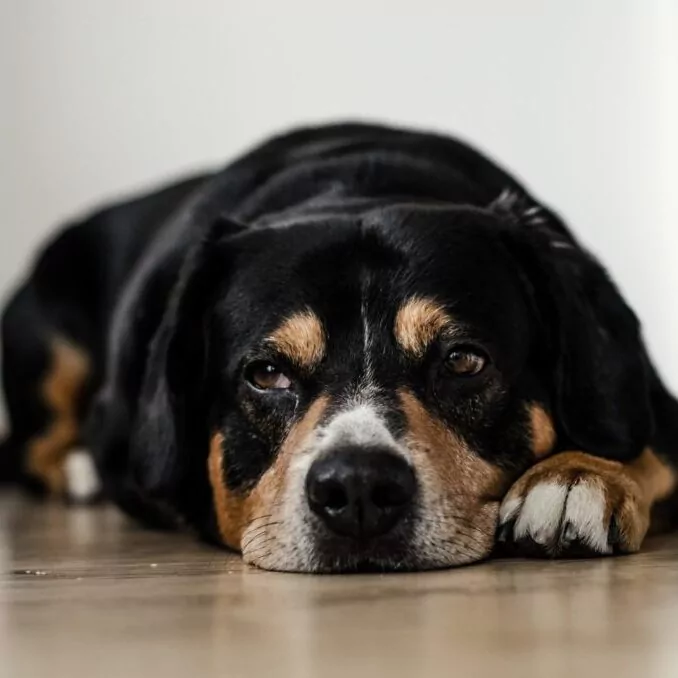Behavior & Symptoms
Separation Anxiety: When Your Dog Has a Panic Attack If Left Alone

Broken teeth. Ripped paw pads. Bloody slashes on the chest and head. Roger the terrier mix hadn’t been in a fight. He’d been left alone. His pet parents had adopted him just a month ago from a local rescue group. They noticed he had become increasingly distressed when left alone for short periods, but due to their flexible work schedules they were able to be home most of the time. A loving couple with no children, they considered this a sort of “paternity leave” to help Roger adjust to his new home. One night, they had been invited to a dinner party. They left Roger alone for four hours. They came home to a nightmare.
Roger had destroyed the metal baby gate keeping him in the kitchen, incurring the lacerations to his head and chest. He then scratched and ate the wood around the front door, trying to get out of the house. The rest of the house was untouched. The couple also found big puddles of drool in the kitchen, which they first thought was pee. While it would take a while for Roger’s body to heal, it would take longer to heal his mind. Roger suffered from separation anxiety.
The term “separation anxiety” has become a popular one. Before you go and Dr. Google a diagnosis, however, realize that true separation anxiety is complicated. As we study the issue more, we’re finding new information.
“There’s actually probably six or seven diagnoses that can fall under the separation-related disorder category,” explains VetScoop correspondent Lisa Radosta, DVM, DACVB, coauthor of From Fearful to Fear-Free: The Ultimate Guide for Fearful Dogs. “What’s important to know is that one size does not fit all. All dogs do not look the same when they are upset about isolation or separation.”
Just because your dog whines when you leave the house doesn’t mean he’s stricken. Just because a dog is destructive when left alone doesn’t mean he has separation anxiety. For example, most dogs cannot be left alone in your home, unsupervised, without training. This goes especially for puppies and adolescents. For example, leave a five-month-old Labrador loose in your home while you go to the store. You may come home to a half-eaten couch. This doesn’t necessarily mean your dog is stressed. It may mean he has not had enough cardio exercise for the day, and he has not been taught to always choose toys for chewing. He wasn’t having a panic attack; he was having a party.
Recognizing Separation Anxiety
“Signs of separation anxiety are going to be generally signs of distress when separated from a pet parent or another animal, or when completely isolated,” says Radosta. “Dogs may exhibit separation anxiety when left completely alone, or when a specific person leaves the home. Dogs can also be overly attached to another animal, such as a canine sibling. When that dog is not present, the other dog panics. Signs of distress can include panting, pacing, vomiting, urinating, diarrhea, hypersalivation (drooling), destruction, and barking.”
Another sign can be that your dog will not eat when you are gone. You may leave him a delicious, food-stuffed toy. When you come home, you find it untouched, but he may then go get it and start eating it. Fear and hunger are not good partners. If you are terrified, you are not craving a snack. Your dog is so afraid when you are gone that he cannot eat.
What Causes It?
Unfortunately, we don’t know all the reasons a dog will develop separation anxiety.
“Dogs who are rehomed are more likely to exhibit separation anxiety in some studies,” Radosta says. “Also, certain breeds, such as Weimaraners, are more commonly represented. Any breed can have separation anxiety, although there is a strong likelihood that there is a hereditary predisposition as well.”
Some factors, such as heredity, you can’t control. Sometimes, the development of separation anxiety is related to your dog’s relationship with you.
Radosta cautions: “Avoid interactions that may cause conflict, such as scolding or punishing the dog for behaviors after the fact or using punishment-based training. For example, the dog gets into the trash when the pet parent is home. This is the pet parent’s fault because they didn’t put the trash away. The pet parent walks into the room and yells at the dog, even just for a couple of seconds. Then, the dog associates the pet parent coming into the room with feeling scared. Now, the pet parent’s approach is paired with excitement, and also with fear. The dog is conflicted. This type of scenario contributes most likely to separation anxiety.”
Be careful that you don’t give your dog mixed signals. It can be flattering when a dog can’t bear to be apart from you. It makes you feel needed and cherished. It’s not a healthy relationship, however, when your dog panics in your absence. This is a dog who is insecure and miserable. Separation anxiety is heartbreaking for dogs and humans alike. Many pet parents feel trapped in their homes, unable to visit friends, go to work, take vacations, or leave the home at all without arranging for their dogs to go to day care or a friend’s or relative’s home. Dogs with separation anxiety are terrified to be left alone. Radosta says one of the greatest gifts you can give your pet is to teach him independence.
How to Help Ease the Panic
Just as the diagnosis of separation anxiety can be complicated, so can be the treatment. A lot will depend on your dog’s symptoms, their severity, and how long this has been going on. In general, treatment will be more successful the earlier you start. Don’t wait, hoping that the problem will eventually go away with time or maturity.
Your first step is to get a diagnosis from your veterinarian. You will then work with a veterinary behaviorist or a professional trainer with experience in separation anxiety. Be sure that any trainer you work with uses modern, reward-based methods. Fear-based tools, such as electronic collars, are not helpful at all for a dog who is already afraid. They will make the problem worse. Crate training generally doesn’t work well with separation anxiety cases, either. Some dogs will hurt themselves trying to escape a crate.
Your veterinarian may or may not recommend medication. Not all dogs will need it, but for some, it can be a literal lifesaver. You may worry that medication will change your dog’s personality, that there will be negative side effects, or that it will impact your dog’s lifespan. You may have tried behavioral medications yourself and have personal opinions regarding their effectiveness.
“The medications used in psychiatric veterinary medicine are widely used and are generally safe in dogs,” Radosta says. “We don’t use any medications that have harsh or dangerous side effects or will shorten life. Most dogs will be on medication for up to six months; however, it depends very much on the pet parent’s ability to implement the associated behavior modification and management changes as well as the pet’s ability to improve.”
Behavioral medication doesn’t typically work by itself. You must also implement behavioral modification to teach your dog he is safe to be alone.
“It is not all about the pet parent; it’s also about that individual pet,” Radosta says. “Some pets will need medications for life, and some will not. Most side effects are transient and disappear when the medication is reduced or discontinued. We are not aiming to change the pet’s personality in a negative way. We are aiming with medications to alleviate suffering. At the end of the day, the animal is suffering, and we have a way to end that suffering and improve quality of life. Why wouldn’t we do that?”
While treatment will depend on the individual case, there are some general things you can do. If you can set up a camera to observe your dog in your absence, this can be helpful. You will be able to show your veterinarian or trainer examples of your dog’s behavior. It can also help you track setbacks and success.
Another exercise to help is to make a list of everything you do before you leave the house. Do you put on shoes, dab on lipstick, grab your keys and your phone? Do you set an alarm? Do you grab a water for the road? Make a list of every step you take, in the exact order.
Now, think about when your dog starts to get anxious. Is it when you toss your keys in your purse? Is it when you kiss your spouse goodbye? Your dog is very good at observing you. He knows when you are about to leave. Chances are that his anxiety heightens as he anticipates your departure.
Perform your departure routine 20 times a day without leaving. Go ahead and get your keys, put on your shoes, kiss your spouse goodbye, go to the door where you’d normally leave … then turn around and put everything back and go back to what you were doing before. Ignore your dog as you do this.
What you are doing is desensitizing your dog to your departure cues. In time, you’ll notice he is more relaxed when you perform each task, because it is no longer a harbinger that you are about to leave.
Some dogs do well with company, but it doesn’t work for all. You can try a reputable day care or pet sitting service. Don’t assume another dog will cure the problem. You might get another dog and find your original dog still panics when you leave. This is because your dog isn’t lonely for companionship in general, he only wants YOU. Worse yet, your dog could teach the new dog to panic, too.
The Sooner, the Better
With all issues, it’s best to start early. This is especially the case with separation anxiety. Fear generally worsens with time if left untreated. If you suspect your dog may have separation anxiety, schedule a visit to your veterinarian right away.
“I wish for separation anxiety and all behavioral clinical signs that pet parents would recognize them as problematic, that veterinarians and dog training professionals would recognize them as important and urgent, and that we would prevent and treat them with the same urgency that we prevent and treat physical problems,” Radosta says.
If your dog has a broken leg, you seek immediate treatment. If he’s so tormented that he can’t bear to be left alone, this matter is just as urgent. Help ease his mental pain now so you both can enjoy less stress. You love your dog, and he adores you. That doesn’t have to change. Sometimes, you both just need some alone time.
Did you find this helpful? Share it!
Questions for your Vet
- Does my dog have separation anxiety? Describe specific symptoms. For example, “He destroyed my house” is not helpful. Instead, try “He ate all around my front window and chewed through the blinds.”
- Will medication help? Don’t be afraid to ask your veterinarian about any concerns you have. Remember that the goal is to ease your dog’s anxiety. Being terrified when left alone is a miserable way to live. Medication can work together with behavior modification to ease your dog’s distress.
- My dog has already injured himself because of his separation anxiety. What can I do short-term until he’s healthy enough to start behavioral modification?
About VetScoop
Pets make our lives better. At VetScoop, we’re on a mission to return the favor by giving you access to trustworthy, science-based information so you can provide the best possible care for your pets.
Related Articles We Think You'd Like





